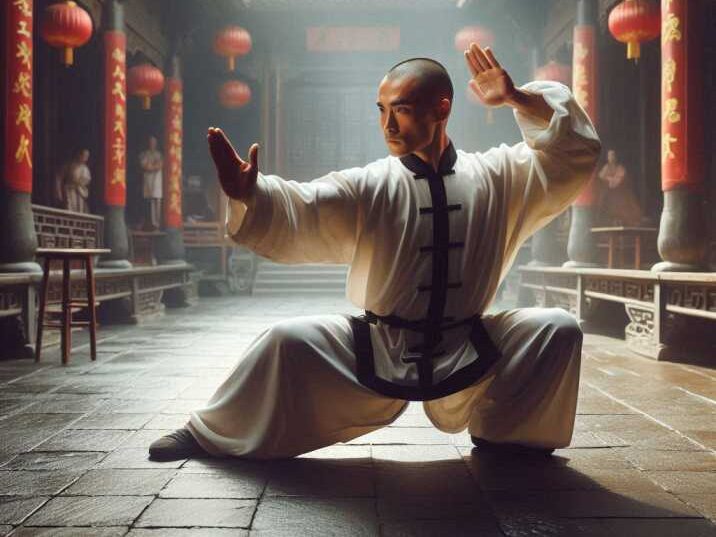Western Boxing and Kung Fu are two popular forms of martial arts, each with its unique history, techniques, and training methods. While Western Boxing focuses on punches, footwork, and defense, Kung Fu emphasizes a more holistic approach, combining strikes, kicks, joint locks, and even meditation. In this article, we’ll explore the key differences between these two combat sports, making it easy for you to understand their characteristics, training styles, and which might suit your interests.

Let’s dive into the differences between Western Boxing and Kung Fu!
1. Origins and History
Table of Contents
Western Boxing:
Western Boxing, also known as “the sweet science,” dates back to Ancient Greece, where it was part of the Olympic Games. It gained popularity in the 18th century in Britain and later spread globally. Today, it’s known for its modern competitive style, where fighters use their hands to strike and block while maintaining fast footwork.
Kung Fu:
Kung Fu is an umbrella term for a variety of Chinese martial arts that have been practiced for thousands of years. Its origins can be traced back to Shaolin Temple monks who used martial arts to defend themselves and improve discipline. Kung Fu has evolved into different styles like Wing Chun, Shaolin Kung Fu, and Wushu, incorporating weapons, forms, and even philosophical teachings.
2. Techniques and Movements
Western Boxing:
In boxing, the focus is on punches such as jabs, crosses, hooks, and uppercuts. Boxers use footwork to dodge and weave around opponents, and their defense revolves around blocking and evading strikes. Since no kicks or grappling is allowed, boxers refine their hand techniques and speed.
Kung Fu:
Kung Fu is known for its diverse techniques, including punches, kicks, blocks, joint locks, throws, and even weapon-based movements. Unlike boxing, Kung Fu teaches a combination of offense and defense through forms, or “katas”, that help practitioners learn sequences of movements. Kung Fu’s techniques often mimic the movements of animals, like the tiger or crane, giving it a more fluid and graceful style compared to boxing’s sharp, direct approach.
3. Stances and Footwork
Western Boxing:
Boxing stances are narrow and focused on keeping the center of gravity low. Boxers move quickly on their feet, shifting from side to side or advancing and retreating with small, sharp steps. This constant movement makes it difficult for opponents to land hits.
Kung Fu:
Kung Fu stances vary greatly depending on the style. Practitioners often use wider stances, like the horse stance, which builds strength and stability. Footwork in Kung Fu emphasizes balance and flow, transitioning between strikes and defenses more gracefully. Kung Fu’s footwork tends to be more circular, while boxing’s is linear.
4. Focus of Training
Western Boxing:
Boxing training is intense and focuses on building stamina, strength, and speed. Boxers spend time practicing on the heavy bag, speed bag, and mitts to perfect their strikes and combinations. Sparring is a crucial part of training to simulate real fights and develop the fighter’s instincts.
Kung Fu:
Kung Fu training is more varied, focusing not only on physical strength but also on mental discipline. Practitioners train through forms, sparring (called “Sanda” or “Sanshou”), and weapons practice. Additionally, Kung Fu often incorporates meditation and breathing exercises to improve focus and inner peace. Some styles emphasize the flow of energy, or “Chi,” in their movements.
5. Rules in Competition
Western Boxing:
Boxing competitions are held in a ring, with fighters required to wear gloves, mouthguards, and protective headgear (in amateur boxing). The sport is based on scoring points for successful punches, or winning by knockout. Boxing matches typically last 3 to 12 rounds, depending on the level of competition.
Kung Fu:
Kung Fu competitions are more diverse. Some focus on forms (pre-arranged sequences), while others emphasize Sanda, a full-contact sparring sport. Kung Fu competitions allow for a wider range of techniques, including punches, kicks, and throws. Protective gear is also worn, but the rules vary depending on the competition format and style.
6. Self-Defense Application
Western Boxing:
Boxing is a great choice for self-defense because it teaches practitioners how to punch effectively and avoid getting hit. Its simple techniques, coupled with speed and power, make it easy to apply in a real-world scenario.
Kung Fu:
Kung Fu is often considered a more versatile self-defense system because it teaches a wide range of techniques beyond just striking. With joint locks, kicks, throws, and even weapons defense, Kung Fu prepares practitioners for various types of attacks, making it a comprehensive system for self-protection.
7. Philosophy and Culture
Western Boxing:
Boxing focuses more on the sporting aspect, with less emphasis on philosophy or spiritual development. It’s all about physical competition and becoming the best athlete in the ring.

Kung Fu:
Kung Fu is deeply rooted in Chinese philosophy, particularly concepts like balance, harmony, and respect for life. Many Kung Fu styles include lessons on discipline, self-awareness, and the importance of inner peace, making it more than just a physical practice—it’s a way of life.
8. Weapons Training
Western Boxing:
Boxing is purely a hand-to-hand combat sport, so there’s no use of weapons in training or competition.
Kung Fu:
Weapons training is a fundamental part of Kung Fu. Practitioners learn to wield traditional weapons like the staff, sword, nunchaku, and spear. This adds another layer to Kung Fu’s versatility and depth in martial arts.
9. Global Popularity
Western Boxing:
Boxing is widely practiced all over the world and has become one of the most popular combat sports. It’s particularly popular in countries like the USA, Mexico, and the UK.
Kung Fu:
While Kung Fu is also practiced worldwide, its popularity is particularly strong in China and among martial arts enthusiasts. With the global success of Kung Fu movies, especially those featuring Bruce Lee, Kung Fu has gained a massive following.
10. Training Benefits
Western Boxing:
Boxing is excellent for cardiovascular fitness, strength building, and improving hand-eye coordination. It’s a full-body workout that helps develop fast reflexes and endurance.
Kung Fu:
Kung Fu provides a more well-rounded approach to fitness, combining strength, flexibility, and mental focus. Since Kung Fu incorporates so many different movements and techniques, it helps improve overall balance and coordination. Moreover, training requires concentration and discipline, which can translate to improved focus in school and other activities.

Table of Differences Between Western Boxing and Kung Fu
| Aspect | Western Boxing | Kung Fu |
|---|---|---|
| Origins | Ancient Greece, modernized in Britain | Ancient China, Shaolin Temple |
| Main Techniques | Punches and footwork | Punches, kicks, throws, joint locks, weapons |
| Training Focus | Speed, stamina, strength | Discipline, forms, mental focus, balance |
| Competition Rules | Punches only, points or knockout | Varied, includes forms and full-contact sparring |
| Self-Defense | Focus on hand strikes | Comprehensive defense including strikes, kicks, and joint locks |
| Philosophy | Physical competition | Balance, harmony, respect, mental discipline |
| Weapons Training | None | Yes (staff, sword, nunchaku, etc.) |
Conclusion
In summary, Western Boxing and Kung Fu are two distinct martial arts with unique origins, techniques, and philosophies. Boxing emphasizes speed, power, and hand-based striking, making it a straightforward and effective form of self-defense. On the other hand, Kung Fu offers a broader range of techniques and a deep connection to Chinese culture and philosophy, making it not only a martial art but a way of life. Whether you’re interested in fitness, competition, or self-defense, both of these combat sports offer valuable skills that can enhance your physical and mental well-being.
FAQs
- Q. Which is better for self-defense, boxing or Kung Fu?
Both are effective for self-defense, but Kung Fu offers a wider variety of techniques, including kicks and joint locks. - Q. Can I learn both boxing and Kung Fu at the same time?
Yes, learning both can give you a more rounded skill set, though they have different techniques and training styles. - Q. Which one is easier to learn for beginners?
Boxing is often easier for beginners due to its straightforward techniques, while Kung Fu requires mastering various forms and movements. - Q. Is Kung Fu good for fitness?
Yes, Kung Fu improves strength, flexibility, and mental focus, making it great for overall fitness. - Q. Do I need weapons to practice Kung Fu?
Not necessarily, but many Kung Fu styles incorporate weapons training as part of their curriculum.


